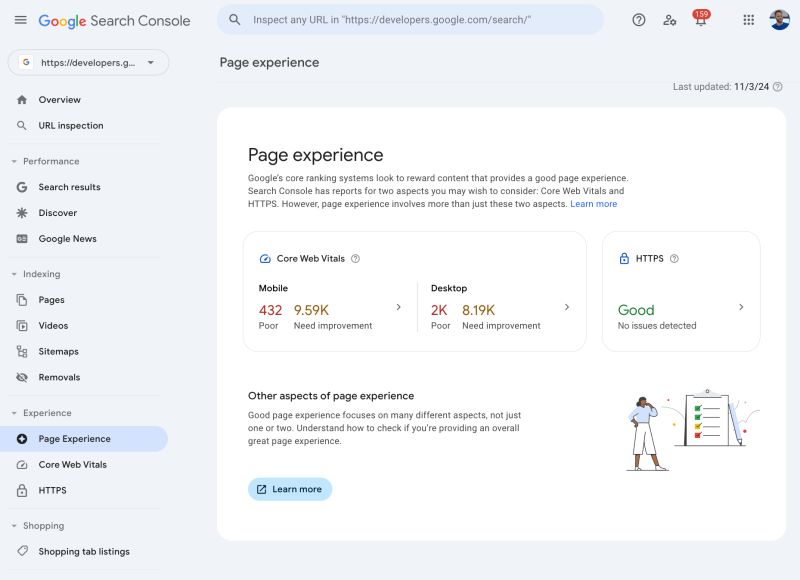Farewell to the Page Experience Report: What This Means for SEO Professionals
Table of Contents
As SEO specialists, we’re no strangers to the shifting landscape of tools and metrics in Google Search Console (GSC). One such shift is Google’s recent decision to retire the Page Experience report, a move that’s both practical and thought-provoking for SEO professionals everywhere.
Why Did Google Remove the Page Experience Report?
Google explained this change as part of their ongoing effort to streamline the Search Console, reducing clutter and simplifying navigation. The Page Experience report combined data from Core Web Vitals (CWV) and HTTPS reports, providing a consolidated overview of a website’s performance in terms of page experience.
However, since both CWV and HTTPS metrics are already available as separate reports, Google deemed the combined page unnecessary. The removal allows webmasters to analyze these components without duplicating information directly.

Reference Image collected from Google Search Central LinkedIn page
Here’s Google’s recent announcement of the retirement of the Page Experience report through their official LinkedIn account:
What Is Not Changing?
Although the Page Experience report is retiring, Core Web Vitals and HTTPS reports remain accessible and essential. These reports will continue to provide the data required to evaluate page experience, including metrics like:
- Largest Contentful Paint (LCP)
- First Input Delay (FID)
- Cumulative Layout Shift (CLS)
- HTTPS implementation status
In essence, the metrics haven’t gone anywhere—only the presentation has shifted.
The Continued Importance of Page Experience
Google’s farewell message underscores an important point: the concept of page experience isn’t going away. A good page experience remains a crucial aspect of delivering value to your visitors. Core Web Vitals are still foundational to ensuring your site meets performance standards that can enhance both user satisfaction and search rankings.
How Should SEO Analysts Adapt?
For SEO professionals, this update requires a slight adjustment in workflow but not strategy. Here’s how we can continue to stay ahead:
- Use Core Web Vitals and HTTPS Reports Directly:
Dive deeper into these separate reports to identify performance issues. Google Lighthouse and tools like PageSpeed Insights can also complement your analysis. - Focus on Holistic User Experience:
Page experience isn’t just about metrics. Pay attention to site usability, mobile responsiveness, and the relevance of your content to user intent. - Communicate with Stakeholders:
Many non-technical stakeholders might misinterpret the removal of the Page Experience report as a reduction in its importance. As an SEO specialist, it’s crucial to explain why page experience still matters and where they can find relevant metrics. - Leverage Automation and Monitoring Tools:
To compensate for the loss of a unified view, integrate tools like Google Analytics 4 or third-party SEO platforms that allow you to consolidate performance data.
Reflecting on the Impact
The removal of the Page Experience report signifies Google’s intent to simplify the SEO toolkit while placing responsibility on specialists to adapt and optimize workflows. This is a reminder that while tools evolve, the principles of good SEO remain constant:
- Provide fast-loading, secure, and user-friendly pages.
- Adapt to changes while staying focused on delivering value to your audience.
As we bid farewell to the Page Experience report, let’s remember that great SEO is not defined by any one tool or metric but by our ability to evolve and refine strategies to meet user needs and search engine standards.
Final Thoughts
Google’s decision to retire the Page Experience report marks a natural progression in their quest to streamline the Search Console. For SEO specialists, it’s not an obstacle but an opportunity—a chance to focus on the individual components of page experience more effectively.
By staying informed, adapting to changes, and continually prioritizing user experience, we can ensure our SEO strategies remain as resilient as ever.
Here’s to the future of SEO, one vital metric at a time!
